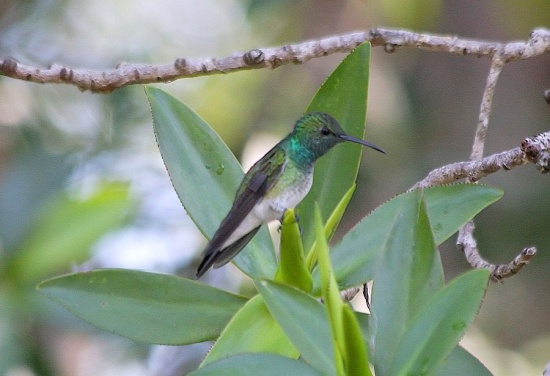- Chrysuronia boucardi
Amazilia boucardi
Identification
10–11 cm (4-4¼ in)
- Bronze and green overall plumage
Male
- Dark bill, reddish lower mandible
- Green crown and upperparts (bronzed on rump and tail)
- Bluish-green throat and breast
- White belly
- Forked tail
Female: similar
- Mainly white underparts
- Small green spots on the throat and sides
Distribution
Endemic to Costa Rica.
Taxonomy
This species was formerly placed in genus Amazilia or in Polyerata.
Subspecies
This is a monotypic species[1].
Habitat
Just as closely linked to mangroves as the name would indicate
Behaviour
Diet
Their main diet consists of nectar from both native and introduced plants.
Breeding
Their small cup nest is constructed from balsa floss, plant down and cobwebs.
References
- Clements, J. F., P. C. Rasmussen, T. S. Schulenberg, M. J. Iliff, T. A. Fredericks, J. A. Gerbracht, D. Lepage, A. Spencer, S. M. Billerman, B. L. Sullivan, M. Smith, and C. L. Wood. 2024. The eBird/Clements checklist of Birds of the World: v2024. Downloaded from https://www.birds.cornell.edu/clementschecklist/download/
- Gill, F, D Donsker, and P Rasmussen (Eds). 2024. IOC World Bird List (v 14.2). Doi 10.14344/IOC.ML.14.2. http://www.worldbirdnames.org/
- Weller, A.A., de Juana, E., Boesman, P. & Sharpe, C.J. (2019). Mangrove Hummingbird (Amazilia boucardi). In: del Hoyo, J., Elliott, A., Sargatal, J., Christie, D.A. & de Juana, E. (eds.). Handbook of the Birds of the World Alive. Lynx Edicions, Barcelona. (retrieved from https://www.hbw.com/node/55504 on 25 August 2019)
- Luther, D. (2024). Mangrove Hummingbird (Chrysuronia boucardi), version 1.1. In Birds of the World (T. S. Schulenberg, Editor). Cornell Lab of Ornithology, Ithaca, NY, USA. https://doi.org/10.2173/bow.manhum1.01.1
Recommended Citation
- BirdForum Opus contributors. (2025) Mangrove Hummingbird. In: BirdForum, the forum for wild birds and birding. Retrieved 8 May 2025 from https://www.birdforum.net/opus/Mangrove_Hummingbird
External Links
GSearch checked for 2020 platform.1





